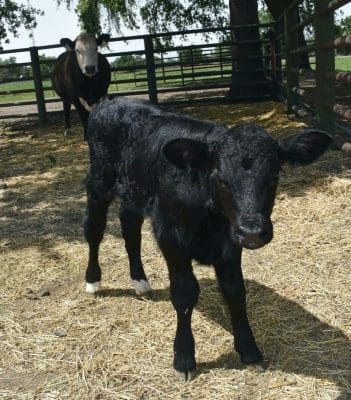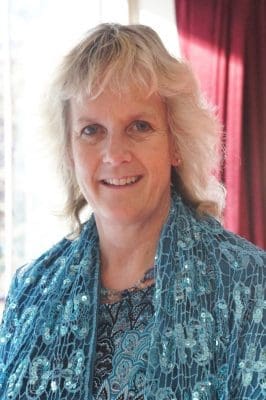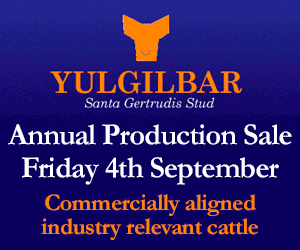US animal scientists at the University of California, Davis, have successfully produced a bull calf that was genome-edited as an embryo to produce more male than female offspring.

Cosmo, a bull calf was born in April at UC Davis. Scientists successfully genome-edited him as an embryo to produce more male offspring. (Pic: Alison Van Eenennaam/UC Davis)
The research was presented in a poster session at the American Society of Animal Science meeting last week.
Using the genome-editing technology CRISPR, researchers can make targeted cuts to the genome or insert useful genes, which is termed a gene ‘knock-in’.
In this case, scientists successfully inserted or knocked-in the cattle SRY gene, the gene that is responsible for initiating male development, into a bovine embryo. It is the first demonstration of a targeted gene knock-in for large sequences of DNA via embryo-mediated genome editing in cattle.
“We anticipate the calf’s offspring that inherit this SRY gene will grow and look like males, regardless of whether they inherit a Y chromosome,” said Alison Van Eenennaam, animal geneticist with the UC Davis Department of Animal Science.
More males, more beef
Dr Van Eenennaam said part of the motivation to produce more male calves than female was that male cattle are about 15 percent more efficient at converting feed into weightgain. They are more fuel-efficient than females. Additionally, they tend to be processed at a heavier weight.
It could also be a win for the environment, with fewer cattle needed to produce the same amount of beef.
“Ranchers could produce some females as replacements and direct a higher proportion of male cattle for market,” said Joey Owen, a postdoctoral researcher in animal science who is leading the project with Dr Van Eenennaam.
An arduous journey

Alison Van Eenennaam
The SRY gene was inserted into bovine chromosome 17, which is a genomic safe harbor site. That ensures the genetic elements function predictably and don’t disrupt the expression or regulation of adjacent genes.
Chromosome 17 was chosen after unsuccessful attempts to knock-in the gene on the X chromosome, which would have resulted in a bull that produced only male offspring. The bull calf, nicknamed Cosmo, is expected to produce 75 percent male offspring – the normal 50 percent XY animals, and another 25 percent XX animals that inherit the SRY gene.
“It took two and a half years to develop the method to insert a gene into the developing embryo and another two years to successfully establish a pregnancy,” said Dr Owen. But in April of 2020, a healthy 50kg male calf was born.
“This has been a real labour of love,” Dr Van Eenennaam said.
 She said this was just the beginning for CRISPR research. Cosmo will reach sexual maturity in a year, and he will be bred to study if inheriting the SRY gene on chromosome 17 is sufficient to trigger the male developmental pathway in XX embryos, and result in offspring that will grow and look like males.
She said this was just the beginning for CRISPR research. Cosmo will reach sexual maturity in a year, and he will be bred to study if inheriting the SRY gene on chromosome 17 is sufficient to trigger the male developmental pathway in XX embryos, and result in offspring that will grow and look like males.
As the Food and Drug Administration regulates gene-editing of animals as if they were drugs, Cosmo and his offspring will not enter the food supply.
Other researchers on the team include James Murray, Pablo Ross, Sadie Hennig and Jason Lin from the UC Davis Department of Animal Science, and Bret McNabb and Tamer Mansour of the UC Davis School of Veterinary Medicine.
This project was supported by Biotechnology Risk Assessment Grant Program from the US Department of Agriculture, the California Agricultural Experiment Station at UC Davis and the USDA NIFA National Needs Graduate and Postgraduate Fellowship.
Source: UC Davis

A quick calculation shows that a central Queensland beef breeding herd turning off “feed on” steers with a sound weaning rate (about 80%), having bulls that deliver two thirds of your calves as males and one third of your calves as heifers will improve herd gross margin by about 2% – as long as it does not cost you anything to get the higher proportion of male calves. Anything more than about two thirds males in the calf crop probably does not provide enough replacement heifers to maintain the breeding herd. The benefits of this technology, if it worked and was allowed, would not be measurable in most Queensland breeding herds.
Thanks for your comment, Fred. Appreciate you running a few sums. Perhaps the numbers might stack up better in the more fertile areas of the US, where the research was conducted, where cow longevity is less of an issue than it would be in large parts of Queensland? Editor
This is unethical and a waste of research dollars. If we just paid attention to the animals we have, by looking after them properly and getting production gains by natural selection we would be far better off.
The unintended consequences for trying to play God can be severe with little real gain in true value.
I think your playing with nature.
less females to select from and less genetic improvement for the next generation. 6 of 1/2 dozen of the other.